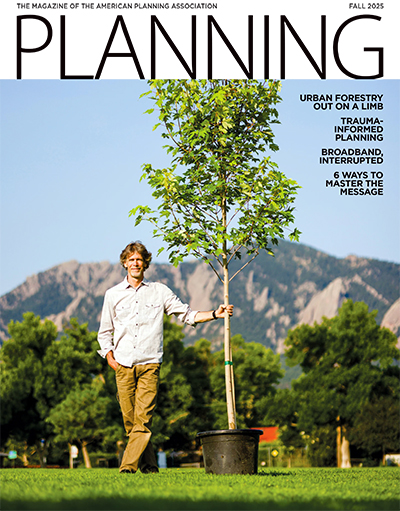Feb. 13, 2025
As the sun began to set on 2024, planners and other urbanism-minded folks were waking up to the ideas, conversations, and community-building opportunities on Bluesky.
The up-and-coming platform began as an initiative of Twitter (now X) in 2019, but it separated after Elon Musk bought Twitter in October 2022. Although Bluesky started sending out invites to users in 2023, it wasn't until recently that its user base began to explode. While we don't know the exact number of planners who have joined the platform, the increase follows a national trend showing Bluesky doubled its users from 13 million in October 2024 to over 26 million in January 2025.
Ryan Richter, AICP, a transportation planner in Chicago, created a Bluesky account in late 2023 but hadn't interacted much with it until around a year later — largely because there were few planners and urbanists on the platform when it launched. "That's really the value of social media," he says. "There has to be some number of people that make this a viable community, otherwise you're just talking to yourself. But [growth] happened really fast with Bluesky."
Anna Brawley, AICP, a planner and elected official in Anchorage, says she finds Bluesky useful for the urbanism community. "I would say Bluesky has a lot of the good features and energy of [X] — it's short-format and [use as] a great way to get breaking news or updates on what's happening," Brawley says. White it's a good place to follow local news outlets, she notes that "not all of the local folks who were active on other platforms migrated over."
Brent Toderian, former chief planner of Vancouver and founder and principal of TODERIAN UrbanWORKS, believes Bluesky has emerged as a successor to what X used to be in the urbanism space. Last year, he began hedging his social media bets, so to speak, by joining Mastodon, Spoutible, Threads, TikTok, Instagram, and Bluesky. For a time, he thought Threads might become the clear alternative to X. Despite Bluesky being the most like X, it was missing key components, like the ability to post videos.
Toderian almost lost interest in the platform. But then Bluesky got innovative by introducing a new feature that none of the other platforms had — starter packs. It allowed users to curate lists of people to follow on the platform with the ease of just a single click.
"It was the perfect tool for the moment," he says. As the platform was growing, the starter pack function "allowed people to find their community. If a few people could work to identify the community members, and if they were well positioned and knew a lot of people, it was an incredibly powerful tool."
Toderian has created seven starter packs to date, including one with climate scientist Katharine Hayhoe and one with former advertising creative Tom Flood, to help "connect the dots" for new users. By having key "hand-holders" showing new users around Bluesky, it helped grow the network of planners. He also started actively recruiting people to join Bluesky, including well-known and influential planners like Jeff Speck, FAICP, Mike Lydon, and Mitchell Silver, FAICP.

This screenshot from February 2025 shows Brent Toderian's Bluesky account, which he uses to hone the messages he creates for his practice and presentations as a planner.

Another screenshot highlights Toderian's starter packs. He created curated lists of accounts to follow in topical categories, helping new users build their networks more easily.
Toderian also has seen a drastic change in his engagement numbers on both X and Bluesky. In past years, he would routinely get 20,000 to 40,000 views on an X post. Now, that number has dwindled to about 2,000. In late December 2024, Toderian conducted a test by posting the same thread on the two platforms. On X, he got one repost, three likes, and 2,500 views despite having 149,000 followers. Meanwhile, on his Bluesky account of around 44,000 followers, he got 28 reposts, 160 quote responses, 125 likes, and 58 comments.
For him, it's not about the ego boost or validation. "I use social media to refine the messaging that I use in my practice and in my presentations and communications," he says. "Twitter had been, and now Bluesky is, the best way for me to test and refine my message."
Leveraging the total app ecosystem
Bluesky isn't the only social media platform planners have adopted to connect with one another and share new ideas.
Thomas Sanchez, PhD, AICP, a professor of landscape architecture and urban planning at Texas A&M University, has been encouraging his students to join LinkedIn, not to necessarily get a job right now, but to find out what kind of job they may want. "I [tell them] if you really want to get a sense of what's happening in your particular area of interest, LinkedIn is a good place to start doing some searching around for people who are doing those things," he says. "Look at what they are posting. Look at what some of the conversations are about. It gives students [the ability] to see what opportunities are out there in planning."
What was once primarily used to seek out jobs or post resumes has become a platform in which second and third connections can provide feedback on research or case studies. And one of the advantages of LinkedIn is that users can see the professional credentials of who they are communicating with on a post. "I've had several experiences where I've posted something and somebody has responded who I probably would've never met otherwise, and we ended up collaborating," Sanchez says.
Pete Saunders, an Illinois-based planner, has found similar success on Substack with his blog The Corner Side Yard. "I did not realize how much of [Substack] is a social media platform that has a blogging and newsletter basis to it," he says. "I've been able to find a lot more people who I think are like-minded and word-focused rather than image- or video-focused."
Saunders, whose Substack originated as a blog on a different web provider several years ago, began writing outside of his normal 9-to-5 because it gave him the chance to look at planning and urbanism in a different way. He wanted to look at issues and challenges that impact cities that don't get the kind of attention they deserve. "That's what I think social media really has to offer to planners," he says. "It's that place where planners can say, 'Where does this fit in the perspective of the work that I'm doing?' I think it gives planners an opportunity to think more broadly."
In that vein, Ray Delahanty, AICP, chose to become a creator on YouTube, where he could explore and share his perspectives on planning topics through video. He launched his series CityNerd on YouTube and now has 340,000 followers. "I had some general ideas of how to put a video together, and I thought most of the things I wanted to talk about were much better explained visually," he says. He didn't expect it to take off the way it did.
Ray Delahanty has created nearly 200 YouTube videos about urbanism, including the video above about train stations in North America.
"It started snowballing [in popularity]. But a key thing about YouTube is that the algorithm is just so powerful. Once you've proven that people are interested in what you're doing and they'll come back for more of it, it will just grow your audience without you having to do [much] except for continuing to make videos of the same quality or appeal."
From a technological point of view, it's pretty easy to get started. Delahanty says he uses his phone for his camera, a laptop, natural lighting, and free open-source editing software. "There aren't a lot of hurdles in terms of capital purchases," he says. "Really, it's the writing. I believe that is what carries my channel."
What comes next for Bluesky?
Mitchell Silver, a former president of the American Planning Association and former commissioner of the New York City Department of Parks and Recreation, is also a Bluesky user — thanks to Toderian, who recruited him. Silver still maintains his X account, which has close to 11,000 followers. But he says he intends to close it later this year. "X is not the same platform as Twitter, which was a place to follow thought leaders, retweet posts, and find important news and trends from trusted sources," he says. Now, he finds the Bluesky experience to be more like what Twitter used to be.
Silver says that Bluesky, where he currently has about 6,000 followers, feels like a welcoming place. "I'm extremely pleased it's growing and becoming the go-to platform for planners, urbanists, trusted sources, and thought leaders," he adds.
As for Brawley, she currently just has a personal account on Bluesky. Comparatively, on Facebook and Instagram, she has both a personal account and professional-facing ones for her role as an Anchorage Assembly member. On those, she says she mostly posts updates on what she's working on, events she has attended, or reminders to the community.
When she does post on Bluesky, it is mostly about advocacy information, calls to action, news articles or relevant information, or giving her opinion on local or state issues. And, yes, occasionally "shouting into the void online, venting how I'm feeling or commenting on something I feel strongly about," she says.
But, like Toderian, she also uses the platform for informal message-testing, "just workshopping some talking points or metaphors I want to use in other contexts."
More and more users are engaging on Bluesky for practical uses. Ryan Richter says he uses it to think through ideas that can be applied to his work. "I've been in conversations with people about something where a new point of view [has] made me rethink my decision or refine my position," he says. "So, in my day-to-day, that's probably made me a more effective communicator."
Richter believes the urbanist community on Bluesky is still in the early stages of development, and X boasts the larger pool of people, with around 611 million active users on its platform. So, even with the surge in Bluesky's popularity, it still has a way to go to reach that layer of the social media atmosphere.
But the next step for the platform will be when larger organizations create accounts. "Transit agencies really embraced X for several years to put out their service alerts," he says. "I think there will be added value to Bluesky if those agencies open an account."
Brent Toderian agrees and believes that when major publications begin citing posts from Bluesky instead of other social media platforms, it will be the final pin to drop. "But I honestly believe it's already past that for city planners and the city-building community," he says, "because there are more elements of that community on Bluesky now than on X."
This story was updated and republished on March 3, 2025.




